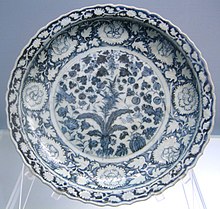
Jiangxi is a landlocked province in the east of the People's Republic of China. Its major cities include Nanchang and Jiujiang. Spanning from the banks of the Yangtze river in the north into hillier areas in the south and east, it shares a border with Anhui to the north, Zhejiang to the northeast, Fujian to the east, Guangdong to the south, Hunan to the west, and Hubei to the northwest.

The Xiang River is the chief river of the Lake Dongting drainage system of the middle Yangtze, the largest river in Hunan Province, China. It is the 2nd largest tributary in terms of surface runoff, the 5th largest tributary by drainage area of the Yangtze tributaries. The river flows generally northeast through the provinces of Guangxi and Hunan, its tributaries reaching into Jiangxi and Guangdong.

Nanchang is the capital of Jiangxi Province, People's Republic of China. Located in the north-central part of the province and in the hinterland of Poyang Lake Plain, it is bounded on the west by the Jiuling Mountains, and on the east by Poyang Lake. Because of its strategic location connecting the prosperous East and South China, it has become a major railway hub in Southern China in recent decades.

Jiujiang, formerly transliterated Kiukiang or Kew Keang, is a prefecture-level city located on the southern shores of the Yangtze River in northwest Jiangxi Province, People's Republic of China. It is the second-largest prefecture-level city in Jiangxi province. Jiujiang literally means "nine rivers".

Shangrao is a medium-sized prefecture-level city located in the northeast of Jiangxi province, People's Republic of China. The city borders the province of Anhui to the north, the province of Zhejiang to the east, and the province of Fujian to the south. Also, the city's western reaches extend into Poyang Lake. Shangrao had a population of 6,491,088 as of 2020 census whom 1,293,399 lived in the built up area made of Xinzhou and Guangxin districts, Guangfeng District not being conurbated yet. Shangrao itself is at the very western edge of the Wu-speaking areas, while most of its associated counties speak Gan.

is one of ten urban districts of the prefecture-level city of Hangzhou, the capital of Zhejiang Province, East China. Fuyang is located in the northwest of Zhejiang on the Fuchun River, a tributary of the Qiantang River. The city is the birthplace of numerous notable individuals, including modern Chinese short story writer and poet Yu Dafu.
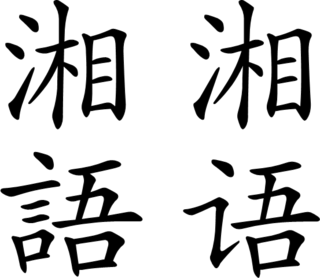
Xiang or Hsiang, also known as Hunanese, is a group of linguistically similar and historically related Sinitic languages, spoken mainly in Hunan province but also in northern Guangxi and parts of neighboring Guizhou, Guangdong, Sichuan, Jiangxi and Hubei provinces. Scholars divided Xiang into five subgroups, Chang-Yi, Lou-Shao, Hengzhou, Chen-Xu and Yong-Quan. Among those, Lou-shao, also known as Old Xiang, still exhibits the three-way distinction of Middle Chinese obstruents, preserving the voiced stops, fricatives, and affricates. Xiang has also been heavily influenced by Mandarin, which adjoins three of the four sides of the Xiang-speaking territory, and Gan in Jiangxi Province, from where a large population immigrated to Hunan during the Ming dynasty.
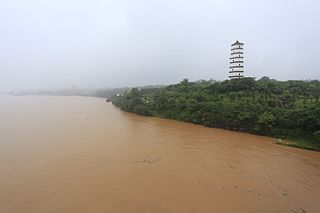
The Gan River runs north through the western part of Jiangxi before flowing into Lake Poyang and thus the Yangtze River. The Xiang-Gan uplands separate it from the Xiang River of neighboring eastern Hunan.
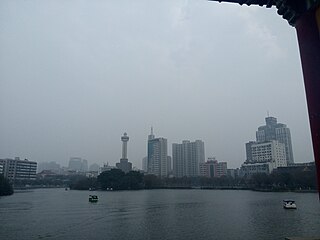
Donghu District is one of 6 urban districts of the prefecture-level city of Nanchang, the capital of Jiangxi Province, China. The district was created in the Tang dynasty when a bridge was built across Nanchang's Taihu lake, dividing the area into the East and West Lake districts. It covers over 56.95 square kilometres (21.99 sq mi) with a population of 482,000 as of 2019. Among them, the urban resident population is 476,300, and the population urbanization rate is 98.83%. The birth rate was 8.68%, and the natural growth rate was 3.2%. People's Park, the largest public park in downtown Nanchang, is located in Donghu.

Sichuanese or Szechwanese (simplified Chinese: 四川话; traditional Chinese: 四川話; Sichuanese Pinyin: Si4cuan1hua4; pinyin: Sìchuānhuà; Wade–Giles: Szŭ4-ch'uan1-hua4), also called Sichuanese/Szechwanese Mandarin (simplified Chinese: 四川官话; traditional Chinese: 四川官話; pinyin: Sìchuān Guānhuà), is a branch of Southwestern Mandarin spoken mainly in Sichuan and Chongqing, which was part of Sichuan Province until 1997, and the adjacent regions of their neighboring provinces, such as Hubei, Guizhou, Yunnan, Hunan and Shaanxi. Although "Sichuanese" is often synonymous with the Chengdu-Chongqing dialect, there is still a great amount of diversity among the Sichuanese dialects, some of which are mutually unintelligible with each other. In addition, because Sichuanese is the lingua franca in Sichuan, Chongqing and part of Tibet, it is also used by many Tibetan, Yi, Qiang and other ethnic minority groups as a second language.
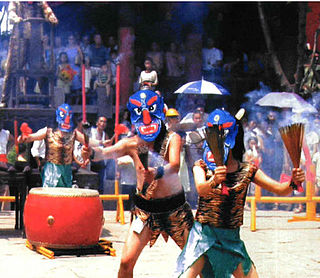
Nuo opera or Nuo drama is one of China's most popular folk operas. Characterized by its special features such as ferocious masks, unique dresses and adornments, the strange language used in performance, and mysterious scenes, Nuo opera has been selected as one of the non-material cultural legacies of China. The opera is a religious performance intrinsic to the culture of Nuoism, a type of Chinese folk religion. The purpose of Nuo opera is to drive away devils, disease and evil influences, and also to petition for blessings from the gods. Singing and dancing are included in Nuo opera and performers wear costumes and masks.

The Gan-speaking Chinese or Jiangxi people or Jiangyou people or Kiang-Si people are a subgroup of Han Chinese people. The origin of Gan-speaking people in China are from Jiangxi province in China. Gan-speaking populations are also found in Fujian, southern Anhui and Hubei provinces, and linguistic enclaves are found on Shaanxi, Sichuan, Zhejiang, Hunan, Hainan, Guangdong, Fujian and non-Gan speaking southern and western Jiangxi.

Gongcheng Yao Autonomous County is a county within the prefecture-level city of Guilin, Guangxi, China. The county spans a total area of 2,149 km2 (830 sq mi), and has a population of approximately 300,000 as of 2011.
Cao Miao is a variety of Dong (Kam) according to Shi Lin (2012). Dialects include Liushi ("Sixty") Miao 六十苗, Sishi ("Forty") Miao 四十苗, and Ershi ("Twenty") Miao 二十苗. The Flowery Miao 花苗 do not consider themselves to be Cao Miao 草苗, although their language is similar to Sixty Miao and Forty Miao.

Fanchengdui is an archaeological site located in Zhangshu city in the province of Jiangxi, China. It is located upstream on the secondary tributary of the Gan River. The Fanchengdui site is located about 23 km east of another archaeological site, Shinianshan. The river Meng flows through the south part of the Shinianshan site roughly from northwest to southeast, before entering a primary tributary of Gan, Yuanshui. Near Fanchengdui the two rivers and Xiaojiang meet, and together they enter Gan river.
Sanqiao is a mixed Dong–Miao language spoken in Liping County and Jinping County, Guizhou, China by about 6,000 people.
Xijiang is a rural town in Leishan County, Guizhou, China. As of the 2016 census it had a population of 20,000 and an area of 187.8-square-kilometre (72.5 sq mi). The town is renowned for its Miao Villages and their custom and human relationships.
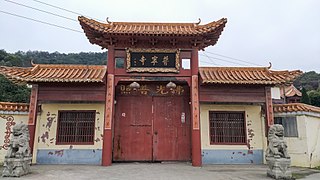
Puning Temple is a Buddhist temple located on Mount Wu'an in Yushan County, Jiangxi, China.

Xiju, also known as Wuxi opera, is a genre of opera which originated in the southern region of the Yangtze River Delta in China. It evolved from "Tanhuang" (滩簧), a folk opera art in the region of Wuxi and Changzhou of Jiangsu province. As one of the main local operas in Jiangsu Province, Wuxi opera has been reputed as "a piece of plum flower in Taihu Lake", a title given to the three major operas in East China, alongside Yue opera and Huangmei opera.
The Yongzhou dialect is a dialect of Xiang Chinese spoken in Yongzhou, Hunan Province.
